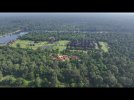Given your intelligence level, you can probably get a job at DJI. Is this really that hard to understand. the
mavic 3 waypoints has a problem when you go from a higher altitude, to a lower altitude, it always overshoots the lower altitude by a large margin. that's why I'm having this problem. is that hard to understand? for instance if you go from a hundred feet, and the next Waypoint is 30, the
mavic 3 will go down to five. that's the problem. Do you have a
mavic 3? you could try this yourself and find out what it does.
I imagine there are quite a few MSc and or PhD at DJI, way above my 'pay grade'.
I don't have a
Mavic 3 so can't test it but you can and you could post the flight log and possibly the waypoint flight plan, they would be interesting to see.
Would you care to?
You could even fly a flight
just to demonstrate this. Just keep the drone under applicable AGL limitations and, so that you can intervene if necessary and the log is complete, close enough to maintain constant control/data connection.
That said, if it is such a common occurrence that "
.... has a problem when you go from a higher altitude to a lower altitude, it always overshoots the lower altitude by a large margin." is applicable, I would have thought that others would have encountered the problem and that there would other threads about it, I do not recollect seeing any.
Have you seen any such threads? If so could you post links to them, they'd be an interesting read and might contain logs and flight plans.
That said it has just come to mind that there was one possible related thread where a drone, type not remembered, might have overshot a lower altitude. I think the flight was around what the British would call a "Stately Home" but the flight was possibly in Europe and the overshoot, if it was an overshoot, was over water, a lake or river. Obviously I don't remember all the details so I can not say this was a
Mavic 3 or even if it was a Fly App flight.
Since "
the Mavic 3" or perhaps 'your
Mavic 3' "
always" descends below the programmed height have you spotted a pattern to the amount by which it "overshoots"?
If so why not raise the programmed height accordingly?
I would also ask
a) why continue to fly flights using the waypoints, especially waypoint flights that will take the drone out of control range where you have no way to intervene?
b) Why not post about the "overshoot" on the DJI forum where the post/thread would draw the matter to DJI's attention, for that matter have you raised the problem with DJI yourself ?











